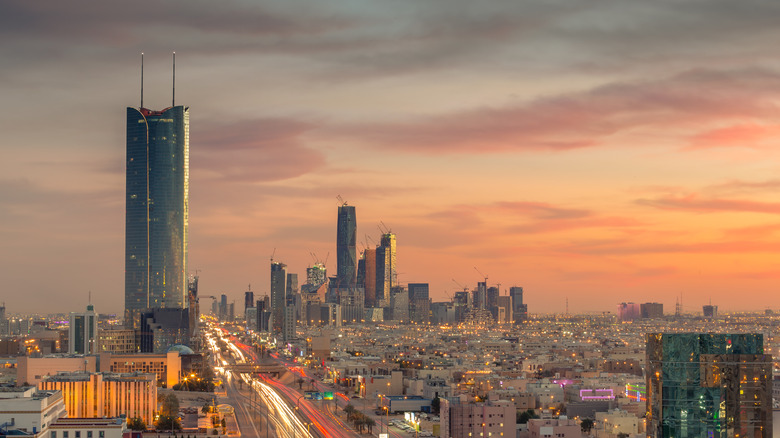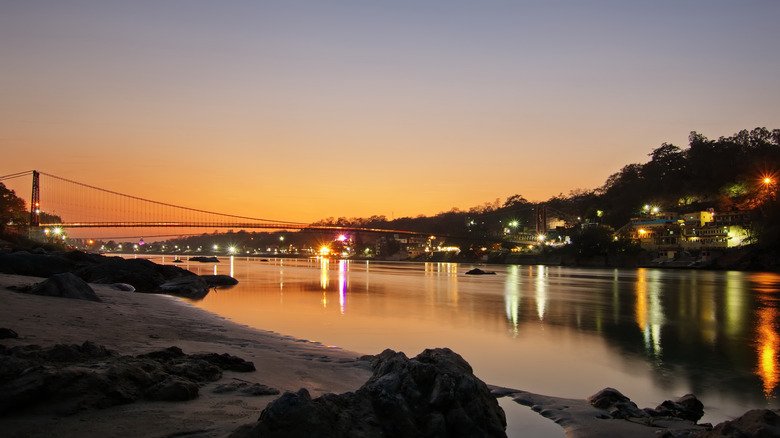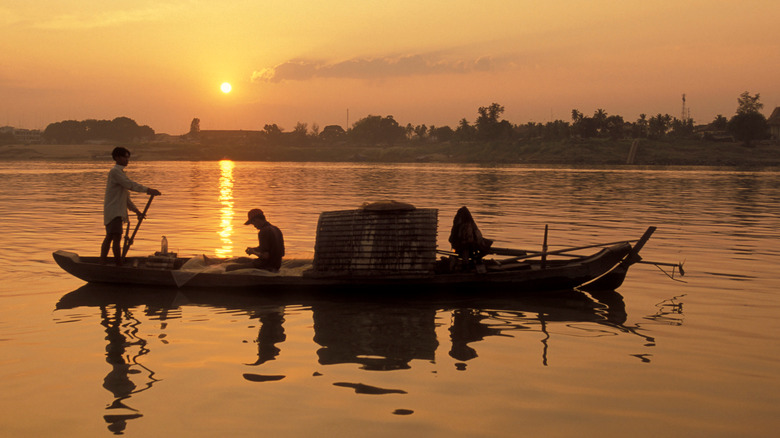Parts Of The World That May Eventually Be Too Hot To Live In
On every news channel — and in just about every media entity that exists — climate change has become a hot topic, but what could the actual consequences be if it goes unchecked?
The phenomenon is insidious. Earth is slowly turning into an inferno, and while the effects aren't always immediately obvious, they could be dire by the end of the century. Maybe when you glimpse public shower heads meant for cooling people off, as seen at the side of a road in Baghdad in a recent CNBC article, that might give away what is happening to our planet on a much larger scale. NASA warns that heat waves are intensifying. If you think fleeing farther north is an escape, hundreds of lives were lost last year when extreme heat seared the Pacific Northwest, shattering records. The heat index uses air temperature and humidity to determine how hot it feels versus actual degrees. Many can soon expect the heat index to hit triple digits repeatedly during the summer, and the U.S. is far from exempt.
The effects of global warming are not nearly as distant as they seem. Baghdad, Shanghai, Mecca, and Buenos Aires may be some of the hottest cities on the planet, but parts of Florida and Texas could soon join them. Overheated places will literally become impossible to live in if nothing is done to reverse harmful emissions, and the human cost in the wake of so much scorching and flooding could end up being tremendous by the next century.
The Persian Gulf
Already known for its blistering summers, the Persian Gulf could soon see temperatures that would not allow anyone to tolerate being outside for long.
Heat is one thing. Add humidity, and you could be looking at conditions that are potentially lethal without air conditioning, according to The New York Times. The actual temperature and humidity outside are one thing. How hot and humid it actually feels can be determined by the wet-bulb temperature, which can be gauged by wrapping a damp cloth around the bulb of a thermometer. Sweat is your body's way of cooling off during a cruel summer. But that automatic inner air-conditioning system won't be able to make you feel any cooler once wet-bulb temps hit 95 degrees Fahrenheit, which translates to a staggering heat index of 165 degrees.
Parts of the Persian Gulf (which was always a hot and humid locale) could end up being a health hazard during the summer. By the end of this century and possibly even sooner, going outside could mean risking your life. The human body would not be able to tolerate more than a few hours of such conditions. As CNN reports, wet-bulb temperatures in the area have repeatedly hit 95 degrees — too high for your system to auto-cool itself with sweat. In Basra, Iraq, some businesses had to implore their employees to stay home during the sweltering days. There are even areas of Kuwait devoid of air conditioning.
North Africa
Lately, Algeria has been seared by temperatures over 120 degrees Fahrenheit, as NBC News observes. This can be both a direct and indirect danger to humans.
Staying inside alone may not save you from hyperthermia. Egypt's water levels are rising along with the sea level and could obliterate all its farmland. Sea levels are steadily rising along with the country's temperatures, and so is the water table, water deep beneath Earth's surface. Egyptians now fear that the ocean could eventually flood the fertile Nile Delta, which could annihilate billions of dollars' worth of crops that sustain both livestock and people. Switching to crops such as rice, which are able to survive in saltwater, and piling more soil on the land to avoid rising sea levels are only temporary fixes for a gradual but deadly phenomenon. Alexandria is especially threatened by heat. If the climate crisis doesn't back down, the city could end up with a quarter of its coast submerged.
Projected temperatures for North Africa in the coming decades are grim. Researchers interviewed by CNBC predict that by 2050, daytime temperatures will be hitting 115 degrees Fahrenheit and barely cooling to 86 degrees after sundown. It gets worse. That region, along with much of the Middle East, will possibly have to sweat through around 200 intensely hot days every year. Desperate Egyptians and others are fleeing to Europe to escape the never-ending heat waves that will only be exacerbated by harmful emissions.
Sub-Saharan Africa
Already infamous for its extreme summers, sub-Saharan Africa is only growing hotter. It could eventually turn into a place that is impossible for human beings to inhabit.
The U.N. is especially concerned about this region because of its reputation for unbearable heat. In the face of climate change that is predicted to raise temperatures on Earth by at least 34.7 degrees Fahrenheit, sub-Saharan Africa would go through the torture of temperatures that exceed that global average. Being so close to the equator already means a high heat index, and the future could bring a surge of heat waves that cause droughts and make farming nearly impossible, as well as nights too hot to sleep through without air conditioning. Preventing a massive spike in temperature means anthropogenic emissions need to go down.
What is especially terrifying about heat waves in this part of the world is that they are underreported because most are not monitored, according to a 2020 study published in Nature (via The Conversation). In most sub-Saharan countries, not much has been done in the way of safety measures during the hottest days of the year, and this lack of warnings means that those who are uninformed — and therefore unprepared — could lose their lives. Deaths caused by hyperthermia are not usually accounted for, either. This is a huge concern when there are expected to be 20 times more people living in this region's cities by 2100 (via Earth's Future). That many more lives will be at risk.
The Red Sea
Being near the ocean doesn't always mean a few degrees of relief. Near the coast of the Red Sea, countries such as Saudi Arabia and Jordan are facing insufferable temperatures.
So how hot is it? Saudi Arabia sometimes gets as hot as the Sahara and could be unlivable by 2070, Earth.org warns. Temperatures in half the country could routinely rival the Sahara by then. One factor that makes this especially hazardous is that every year, millions of Muslim pilgrims journey to the city of Mecca, which is now considered the hottest place on Earth where humans actually live. City dwellers at least have access to air conditioning. Because the Saudis realized they needed to do something to counteract the heat, it is often possible to go from home to work and back without ever stepping outside on the most sweltering days, but rural areas don't always have access to air conditioning.
Jordan suffers from drought after drought because of rising heat and water being diverted into surrounding countries such as Syria. Stanford University reports that water shortages by the end of the century could be an everyday occurrence unless alternative methods of tapping into drinkable water (such as converting seawater) are used. Population growth, mostly due to immigration, doesn't exactly help. In a study published in Science Advances, researchers reveal that Jordan, a mostly landlocked country that was already thirsting for water to begin with, does not see much rain. Predicting droughts sounds like the answer, but is also notoriously difficult.
Central and South America
In a region of countries that are either just above or south of the equator, there is going to be heat and humidity — but climate change means that has started to skyrocket.
Extreme heat has caused hundreds of thousands of deaths in Latin America, according to Science.org. Buenos Aires and many other cities on the southern end of South America recently suffered a devastating heat wave. Besides having to put up with temperatures over 104 degrees Fahrenheit, which exacerbated an ongoing drought and set off wildfires, Buenos Aires also suffered from its power supply burning out. Not everyone survived. There were several deaths reported — and nobody knows how many succumbed to the heat for sure. Heat waves will only become more dangerous as urban sprawl continues.
Cities like Buenos Aires and Rio de Janeiro see the most summer fatalities. For every 33.8 degrees the temperature creeps up on already sizzling days, the death risk also rises by 5.7%, which does not bode well for an area of the world where the population is growing older and more vulnerable. The elderly are less likely to tolerate such drastic highs. The World Meteorological Organization (WMO) states that ocean warming, rising sea levels, and the droughts, heatwaves, hurricanes, and floods that come with them have ravaged much of Latin America. Glacier melt also means that the freshwater supply for many cities around the Andes is dwindling. The WMO believes early warning systems need to be upgraded.
South Asia
Humanity may not be able to take the heat in many parts of South Asia by the end of the century. With temperatures soaring, the mortality rate could rise decades before that.
Heat waves can kill thousands in this region during just one summer. According to Reuters, in India alone, the 2% of its population that is now exposed to extreme bouts of heat could become 70% by 2100. Northern India, Bangladesh, and the south of Pakistan are the most prone to overheating, which means the lives of some 1.5 billion people, and more as the population rises, will be at risk. Urban areas are in the most danger, as a study published in Science Advances found. Researchers found that temperatures in some cities are already approaching the limit that the human body can survive, and that the most extreme heat waves will scorch the Indus and Ganges river valleys. Agricultural workers in these areas toil outside during the worst months — which will only grow hotter in the not-so-distant future.
Some cities are already taking action. As Reuters says, the heat-wave warning system introduced in the Indian city of Ahmedabad is the first implemented in South Asia. It identifies where the most vulnerable populations live and has taken advantage of malls, temples, and public buildings during the summer to create safe havens known as "cooling spaces." Citizens who may not have access to air conditioning can stay in these spaces until the heat subsides.
Eastern China
Not only is eastern China one of the most densely populated regions on Earth, but it is also one of the most sweltering, plagued by heat and humidity. This could mean disaster.
Besides having the highest population density in China, the east is also the epicenter of Chinese agricultural production, according to MIT. Humidity in this relatively dry area is actually caused by irrigation. When water evaporates in temperatures close to or in the triple digits, it brings about choking humidity that makes the already unbearable heat feel even hotter. Being closer to the water's edge when oceans are rising and warming already makes it even worse. Eastern China may be the one region on Earth that is at more risk for extreme heat waves than any other, and an immense heat wave in Shanghai during the summer of 2013 not only took dozens of lives but also smashed a record that hadn't been broken in 141 years.
Shanghai's heat problem recently led to the city going dark at night in desperation to save energy, as CNN reports. Other parts of China have also been feeling the heat. Sichuan, which lies in southwestern China, exports energy to the east but barely has enough to power itself. Its 80 million people experienced a widespread power shutdown brought on by a monstrous heat wave. The blackouts also cut off air conditioning, which meant the demise of thousands of livestock when it hit poultry and fish farms, next to the inevitable human suffering.
Southeast Asia
Rising temperatures in this region have already caused typhoons, flooding, and other natural disasters that have killed thousands and displaced hundreds of thousands of others in 2020 alone, according to the Center for Strategic and International Studies (CSIS).
The situation is dire. Most of the Southeast Asian population – about 77%, per the Global Environment Facility — is concentrated near river deltas or on the coast. Sea levels in the region are expected to rise by 20 to 28 inches by the close of this century and become intolerable much sooner, by around 2050. It is predicted that high tides will bring on floods and make many of these areas unsafe, forcing their inhabitants to migrate somewhere more livable. Annual flooding could displace even more people. The Guardian also notes that more days are becoming too hot for many to work, meaning that Southeast Asia could lose much of its labor force because of heat levels that could put employees at risk of illness and possibly death. Suffering from this the most are Malaysia and Singapore, followed by Indonesia, Cambodia, the Philippines, Thailand, and Vietnam.
Because the entire region could also become politically and economically unstable if climate change stays on the upswing, with a food and water crisis predicted for the future if nothing is done, there are plans to combat climate change and prevent devastation. The problem is that these projects often do not receive enough financial backing. That, along with the lack of focus on adaptation strategies, could threaten the future.
Southern Europe
Though the Mediterranean Sea already flows through some of the hottest regions on Earth, such as northern Africa and the Middle East, parts of southern Europe that are mostly on the Mediterranean coast are both growing hotter and drying out.
Sunblock has not been enough to save the tourist industry in some places, as The Guardian learned. Spain's tourist industry has taken a hit from increasing heat. It used to be that vacationers would flock to the southern shores of the country during August. Now that August has become nearly unbearable, more trips are being booked for June and September, and if the planet keeps growing hotter with no relief in sight, peak travel season might change again in a few decades. Another Guardian article highlights a heat wave so severe that newscasters in Spain called it "hell," or "El infierno." Tourists wandering Rome sought relief in public water fountains. In Paris, rooms in public buildings were designated as air-conditioned refuges, while pools stayed open late.
That heat wave that boiled the south of Europe swept up scorching air from the Sahara and brought it to the southern parts of France, Spain, Italy, Greece, and even Switzerland and Germany. It broke records in several countries with highs up to 104 degrees Fahrenheit. Higher temperatures have also been steadily — and unexpectedly — heading north. Because the heat wave threat is so imminent, the European Union is making efforts to keep their 2015 Paris climate accord pledge meant to drastically reduce carbon emissions.
The American Midwest
While the effects of global warming may seem like faraway issues affecting the other side of the planet, all of Earth is suffering, and that includes the U.S. The heat is about to hit home.
From northern Texas through Louisiana, Iowa, Indiana, Illinois, and all the way up to Wisconsin stretches what is now considered an "Extreme Heat Belt" with unbearable humidity, according to ABC News. It won't even take until the next century to see how hot the summers will get. It is predicted that by 2053, the heat index will mean that at least one day a year will feel like 125 degrees Fahrenheit for residents of more than 1,000 U.S. counties (not that it will actually be much cooler outside). High temps are forecasted to rise 13 times in just three decades. The 8 million Americans who will be cranking up the AC this year will eventually be 107 million Americans by the 2050s.
The Midwest has a water disadvantage, and that region seems even hotter because of how humid it can be, according to CNBC. People may start packing up and leaving areas that are often drowned by floods or burned by wildfires. Since global warming will only intensify that kind of weather, migrations due to unbearable climate, which have already started, are expected to happen more frequently within the next 30 years. The Extreme Heat Belt will eventually swallow a quarter of the country if emissions keep rising at the rate they are. America is hardly immune to potential devastation.
The American South
At least in the U.S., what could possibly be worse than the hellish Extreme Heat Belt? That would be the region where intolerably hot days will double relatively soon: the South.
As CNBC reports, the South is seeing the worst warming trend of all. At the highest risk of becoming unbearably hot are Florida and Texas, both of which have seen an influx of new residents who have moved there with the hopes of an eternal summer. They won't be living that fantasy for long. Florida is predicted to turn into a swampy, humid oven, with rising sea levels wiping out homes and buildings along the coast while heat waves go from summertime nuisance to bona fide hazard. Most of Texas will also bake in the relentless sun along with Georgia, Alabama, and other Southern states, as The New York Times says.
While temperatures in these locations and others affected by climate change continue to rise, their economies will suffer as properties are wrecked and residents find they have no other choice but to move. Outdoor labor will probably see a decrease. Deaths caused by heat could eventually equal the yearly fatalities from car accidents if there are no precautions taken. Air conditioning means energy, and as Americans use more energy to withstand the summers, it could mean that costs will go up with the temperatures. Energy grids may also become overwhelmed and possibly shut down. Sound familiar? If it happened in Sichuan, it can happen here.











